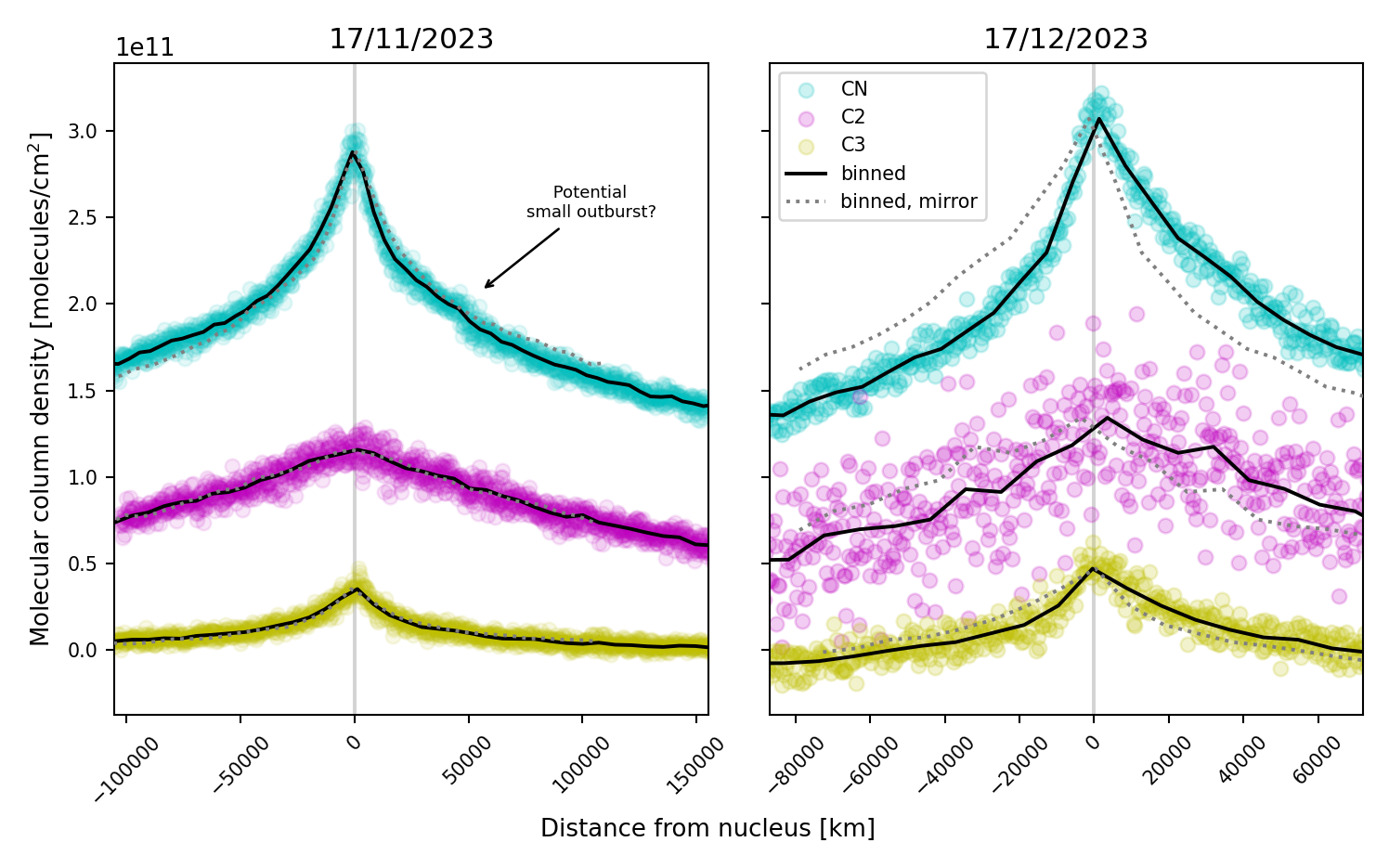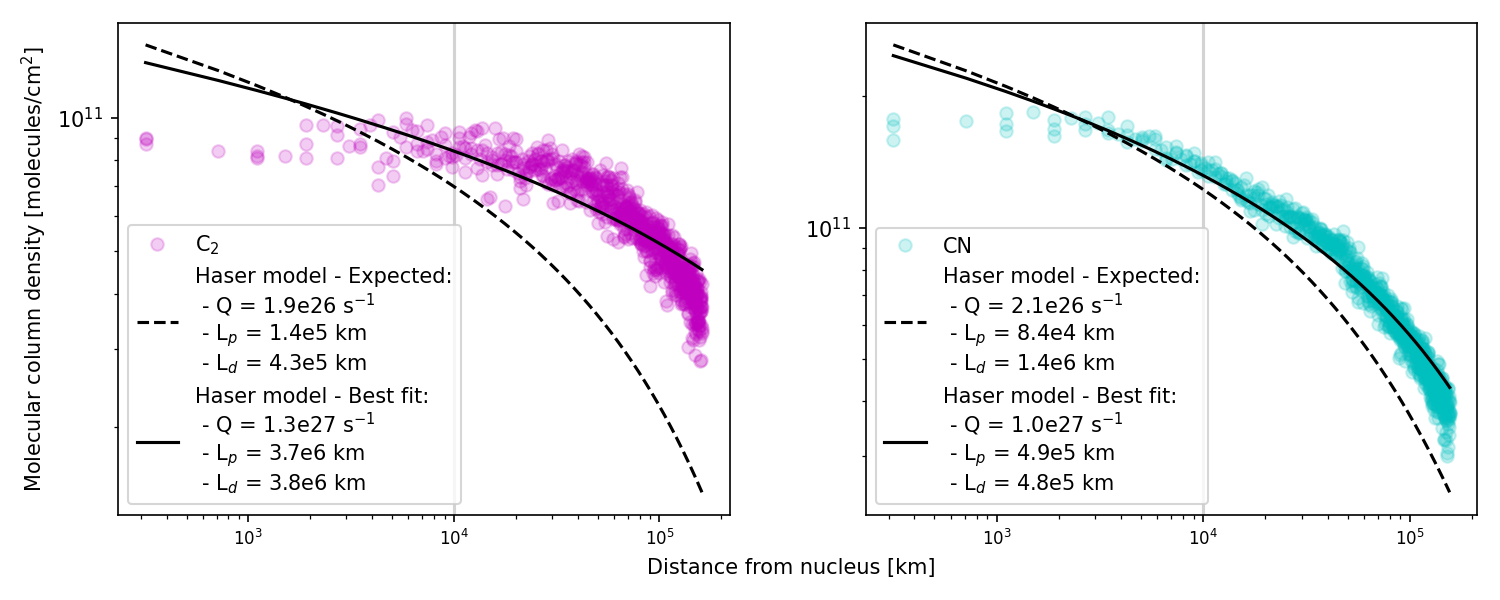Coma composition and profiles of 12P/Pons-Brooks from long-slit spectroscopy
- Institute for Astronomy, University of Edinburgh, Edinburgh, United Kingdom (lea.ferellec@ed.ac.uk)
I–Introduction
Comet 12P/Pons-Brooks is a Halley-type comet discovered in 1812. Returning every 71 years from just beyond the orbit of Neptune, outbursts were reported during each of its apparitions since. On its way to its most recent perihelion passage (21/04/2024) the comet exhibited large outbursts, such as on 20/07/2023 (magnitude ∼17 to∼12) or 14/11/2023 (magnitude ∼14 to∼9), with several smaller outbursts in between.
Outbursts can be linked to mechanical processes (e.g fragmentation), external phenomena (e.g collisions) or internal physico-chemical processes (e.g. crystallisation of ice)[1]. Regular outbursts on 12P might indicate that its structure or make-up are to blame. The 2024 return of the comet presented a perfect opportunity to study its composition and behaviour.
II–Methods
Long slit spectra of 12P were acquired with the Isaac Newton Telescope(INT) IDS on 23/08/2023, 17-18/11/2023, and with the Nordic Optical telescope(NOT) ALFOSC on 17/12/2023. They cover the spectral range 304-640nm for INT-IDS and 350-535nm for NOT-ALFOSC, probing emission regions of common radicals such as CN, C2, C3, etc. We calculated molecular production rates Q and upper limits of OH, NH, CN, C2 and C3 by comparing the integrated flux within a 10000km distance from the nucleus to a standard Haser model. We used a gas velocity of v=1km/s as well as commonly used scale-lengths and fluorescence factors. We also produced column density profiles of CN, C2 and C3 along the spectrograph slit (aligned with the parallactic angle). These can help searching for features, studying the release mechanisms of species by comparing them to models, etc.
III–Results
Based on our observations (e.g. Fig. 1), the composition of 12P (Table 1) seems typical, although slightly carbon-depleted (average Q(C2)/Q(CN)=0.913±0.053) and slightly low in OH compared to other radicals. Abundance ratios do not seem to vary significantly from November to December and seem in agreement with preliminary production rates from the TRAPPIST telescopes (e.g. [2]). Paired with these measurements, our observations from November show a decline of the 14/11/2023 outburst gas release within a few days.
In November, we measure slightly asymmetrical profiles for C2, C3 and CN. In December, the asymmetry is even stronger (Fig. 2). This is consistent with multiple reports of a complex coma morphology (e.g [3]). A faint feature is visible in the CN profile on 17/11/2023, which could be a minor outburst amidst the large 14/11/2023 outburst. While C2 and C3 would be expected to have similar release mechanisms, the C2 profiles look particularly “flat” while C3 and CN look more “peaked”, perhaps indicating a separate origin.
As illustrated by Fig. 3, the expected Haser model with empirical scale-lengths fails to reproduce the observed profiles. For all profiles, adjusting the model with variable scale-lengths and Q values returns parent and daughter scale-lengths that are close to equal. These parameters translate into profile shapes in log-scale that are more angular (flat then sharply decreasing) than expected with the Haser model and usual parameters. Such shapes can also be obtained by more complex Haser models such as three-generation or grain-halo models[4]. This could suggest the presence of extended sources in the coma, especially for C2 which seems to behave unusually. With the Q values found by adjusting the Haser model parameters to the profiles, the comet does not seem carbon-depleted anymore. While the adjusted profiles still do not exactly match the observations (especially for C2), this highlights the complexity of composition measurements and classification for “unusual” comets for which the standard model may not apply.

Figure 1 – Average INT-IDS optical spectrum of comet 12P on 17/11/2023, integrated within 10000km from the nucleus, showing detection of emission lines from several species.
|
|
23/08/2023 |
17/11/2023 |
18/11/2023 |
17/12/2023 |
|
QOH [1028 s-1] |
<3.71 |
5.71±0.60 |
5.35±0.55 |
/ |
|
QCN [1026 s-1] |
0.218±0.110 |
2.10±0.13 |
1.63±0.10 |
1.63±0.10 |
|
QC2 [1026 s-1] |
<0.436 |
1.93±0.16 |
1.46±0.12 |
1.50±0.12 |
|
QC3 [1025 s-1] |
<0.193 |
1.20±0.13 |
0.905±0.081 |
1.01±0.10 |
|
QNH [1026 s-1] |
<4.82 |
2.22±0.19 |
<2.76 |
/ |
Table 1 – Molecular production rates and abundance ratios calculated from INT-IDS (2” slit-width) and NOT-ALFOSC (1” slit-width) spectra of 12P (e.g. Fig 1) using a standard Haser model (v=1km/s) in a 20000km wide aperture.

Figure 2 – Column density profiles of CN, C2, C3 along the spectrograph slit on 17/11/2023 and 17/12/2023 (added y-offsets for C2 and C3). Solid black lines show the average binned data, dotted gray lines show these binned profiles reversed along the x-axis. A bump is visible 50000km away from the nucleus on 17/11/2023 which could be a minor outburst. Unlike CN and C3, the C2 profiles appear almost linear with the radial distance.

Figure 3 – Column density profiles of CN, C2, C3 along the spectrograph slit (one side only) on 17/11/2023, with expected Haser model profiles and best Haser model fits. The models use v=1km/s. Expected models use literature scale-lengths and Q values from Table 1 (vertical grey lines indicate our 10000km aperture).
Acknowledgements
We acknowledge contributions from J.P.U. Fynbo and U.G. Jorgensen for the 12/2023 NOT data as well as A. Donaldson and R. Kokotanekova for the 08/2023 INT data.
References
[1] Hughes, D.W. (1990). Cometary outbursts - A review. QJRAS, vol. 31, pp. 69–94.
[2] Jehin, E. et al., (2023). TRAPPIST bright comets[…]. ATel, 16338.
[3] Knight, M.M. et al., (2024). Rotation period[…]. ATel, 16508.
[4] Combi, M.R., & Fink, U. (1997). A Critical Study[…]. AJ, 484(2), 879.
How to cite: Ferellec, L. and Opitom, C.: Coma composition and profiles of 12P/Pons-Brooks from long-slit spectroscopy, Europlanet Science Congress 2024, Berlin, Germany, 8–13 Sep 2024, EPSC2024-313, https://doi.org/10.5194/epsc2024-313, 2024.